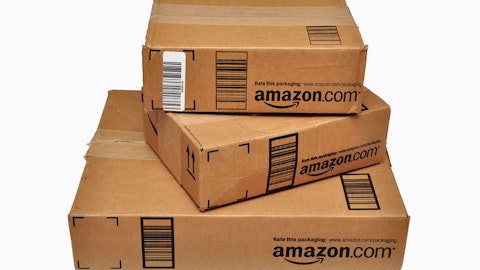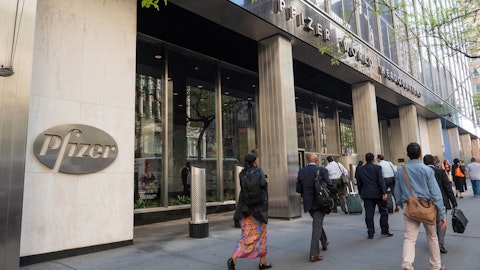Post Holdings, Inc. (NYSE:POST) Q1 2023 Earnings Call Transcript February 3, 2023
Operator: Welcome to Post Holdings’ First Quarter 2023 Earnings Conference Call and Webcast. Hosting the call today from Post are Rob Vitale, President and Chief Executive Officer; and Matt Mainer, Chief Financial Officer and Treasurer. Today’s call is being recorded and will be available for replay beginning at 12:00 p.m. Eastern Time. The dial-in number is 800-839-6136. No pass code is required. At this time, all participants have been placed in a listen-only mode. It is now my pleasure to turn the floor over to Jennifer Meyer, Investor Relations of Post Holdings for introductions. You may begin.
Jennifer Meyer: Good morning and thank you for joining us today for Post’s first quarter fiscal 2023 earnings call. With me today are Rob Vitale, our President and CEO; and Matt Mainer, our CFO and Treasurer. Rob and Matt will begin with prepared remarks. And afterwards, we will have a brief question-and-answer session. The press release that supports these remarks is posted on our website in both the Investors and the SEC filings section at postholdings.com. In addition, the release is available on the SEC’s website. Before we continue, I would like to remind you that this call will contain forward-looking statements, which are subject to risks and uncertainties that should be carefully considered by investors as actual results could differ materially from these statements.
These forward-looking statements are current as of the date of this call, and management undertakes no obligation to update these statements. As a reminder, this call is being recorded and an audio replay will be available on our website. And finally, this call will discuss certain non-GAAP measures. For a reconciliation of these non-GAAP measures to the nearest GAAP measure, see our press release issued yesterday and posted on our website. With that, I will turn the call over to Rob.
Rob Vitale: Thanks, Jennifer, and thank you all for joining us. Post had quite a solid quarter, while all segments performed well, Foodservice performance exceeded expectations, and contributed to our outlook revision for the balance of fiscal 2023. Most encouragingly, we are confident that the sustainable EBITDA level for Foodservice has reset to approximately $350 million prior to considering the contribution from our ready-to-drink shake plan that comes online late this year. Last quarter, we talked about margin restoration. Compared to last year, we expanded gross margin by 170 basis points. We expect some give and take throughout the balance of the year including a dip in the second quarter. However, this quarter’s expansion is expected to largely mirror our full-year results.
Key drivers of margin expansion include pricing and supply chain execution, offset by mix. The pricing environment remains inflationary, but at a slower rate. Data Âdriven price increases remain achievable and elasticities in most categories remain relatively low. Supply chains are demonstrably better the fill rates continue to be below pre-pandemic levels. As I have mentioned, we view supply chain recovery as more of an ongoing process than a singular event we once expected it to be. Meanwhile, the shift towards more value price points is a margin headwind than in most of our category is dollar accretive. To give you some more detail and perspective on the individual businesses, Post consumer brands maintained a branded dollar share position of 19.1%.
Meanwhile, our private label business grew 13.6%. Interestingly, we have seen a stepped-up level of competitor advertising intensity, which we believe is constructive for the overall category. As I mentioned, Foodservice remained strong both in volume and pricing. For some time, we have signaled our expectation that this business would emerge from the challenges of COVID and avian influenza in an improved position. We believe that is rapidly becoming clear and forms the estimate I gave surrounding sustainable EBITDA. Notably, we expect to operate at approximately that level in the second half of this fiscal year. Refrigerated retail continues to show mixed results. Our supply chain has markedly improved versus this time last year. That recovery supported 12% volume growth in our core side dish category.
We do see some expansion of private label distribution. In this category, we do not make private label. We are leaning into heavier brand investment to support both expanded distribution and velocities. Liquid eggs remain under pressure as high path avian influenza costs have driven our pricing and resulted in elasticities among the highest in grocery. Weetabix continues to be well managed in a challenging environment. The margin pressure from elevated energy prices, which we highlighted last year, developed as expected and will persist throughout the year. In addition to higher incremental costs, the impact on consumers drives mix towards private label. Our small acquisition of the UFIT brands has gone exceptionally well with sales up over 30%, when compared to the prior pre-acquisition period.

Photo by Ben Tofan on Unsplash
As we mentioned last quarter, we continue to believe the current challenges in the capital markets, especially the debt markets, create opportunities for Post in M&A. We remain interested in opportunities both large and small that could complement an existing business or provide entry to a new category. This quarter, our capital allocation skewed towards bond rather than share repurchases as that same debt market volatility created unusually attractive prices. This quarter, we sold our remaining stake in BellRing brands. All told, our investment of a little over $700 million generated after tax proceeds of $2 billion and resulted in a distribution to shareholders of an additional $2 billion. The future is bright and I’m excited to see the BellRing story continue to develop.
Last but not least, we revised our guidance yesterday evening. We increased our outlook to an adjusted EBITDA range of $1.025 billion to $1.065 billion to reflect year-to -date results and an increased optimism in the condition of the business. While we have yet to plan fiscal ’24, our initial thinking is that despite some non-repeatable current year benefit, we expect to maintain or grow overall EBITDA in fiscal 2024. With that, let me turn the call over to Matt, who will go into more detail on the quarter.
Matt Mainer: Thanks, Rob, and good morning, everyone. First quarter consolidated net sales were $1.6 billion and adjusted EBITDA was $270 million. Net sales increased 17%, driven by pricing actions in each segment as overall volumes were relatively flat. Certain pockets of our business saw a modest shift to private label. We continue to see incremental improvement in supply chain performance and customer order fill rates. However, both remain below optimal levels. And while significant inflation contained in the quarter, there do appear to be signs of moderation. Turning to our segments and starting with Post consumer brands, net sales increased 9% and volumes decreased 1%. Average net pricing increased 11%, driven by pricing actions, partially offset by unfavorable product mix and incremental promotion.
We saw strong growth in Peter Pan and private label cereal. These gains were offset by declines in Honey Bunches of Oats, government business and MOM bags. Adjusted EBITDA increased 5% versus prior year as our pricing actions outweighed significant cost inflation and higher manufacturing expenses. Weetabix net sales were flat year-over-year. In local currency, however, sales were up approximately 14%, a significantly weaker British pound caused a foreign currency translation headwind of approximately 1,400 basis points. Net sales benefited from significant list price increases and contribution from last April’s acquisition of the UFIT brand. These benefits were partially offset by unfavorable mix reflecting growth in private label products.
Excluding the benefit from UFIT, sales declined 6% and volumes declined 1%. Growth in private label was not enough to offset decline in branded products, which were largely driven by supply chain constraints and related shortfalls in order fulfillment. Segment adjusted EBITDA was 18% lower than prior year, primarily because of foreign currency translation headwinds. Additionally, our adjusted EBITDA margin stepped down as supply constraints were compounded by higher input and warehousing costs. Given the challenging macro environment in the U.K., our overall outlook assumes margins are compressed throughout 2023. Turning to Foodservice, net sales and volume grew 37% and 4% respectively. Revenue growth continued to outpace volume growth as revenue reflects the impact of inflation driven pricing actions, the effect of our commodity pass-through pricing model and avian influenza-driven pricing actions to offset higher cost to procure eggs on the spot market.
Segment adjusted EBITDA grew to $109 million, benefiting from an improved average net pricing and volume growth, which combined mitigated the impact of higher cost to produce. Refrigerated retail net sales increased 7%, while volumes decreased 5%. Note that excluding the divested Willamette Egg Farms business, net sales increased 10% and volumes increased 1%. Pricing actions drove increases in average net selling — average net pricing across all products. Side dish volumes increased 12%, reflecting improved inventory levels that allowed us to meet demand for the holiday season. Egg volumes decline is elevated egg cost and limited case free availability from avian influenza hurt both volume and margins. Segment adjusted EBITDA increased 12%, primarily benefiting from access to offset significant cost inflation.
Higher volumes also drove improved manufacturing levers. The reinstatement of advertising and promotion wasn’t offset to these benefits. Turning to cash flow. In the first quarter, we generated $98 million from continuing operations and was driven by profitability offset by — higher profitability year-over-year versus higher working capital. Our net leverage decreased half a turn this quarter to 5.1 times driven by growth in adjusted EBITDA. Moving on to capital allocation. In the first quarter, we repurchased 300,000 of our shares at an average price of approximately $85 per share and $71 million of our debt at an average discount of 15%. We have $276 million remaining under our share repurchase authorization. With that, I would like to turn the call back over to the operator for questions.
See also 10 Hot Healthcare Stocks To Buy Now and Michael Burry Stock Portfolio: 10 Stocks He Sold .
Q&A Session
Follow Post Holdings Inc. (NYSE:POST)
Follow Post Holdings Inc. (NYSE:POST)
Operator: We’ll take our first question from Andrew Lazar with Barclays.
Andrew Lazar: Good morning, everybody.
Rob Vitale: Hey, good morning, Andrew.
Matt Mainer: Good morning.
Andrew Lazar: I guess to start, Rob, I think in fiscal 4Q, you talked about the Foodservice segment EBITDA obviously was well ahead of what you see as a normalized run rate. And I think for 1Q, you said you didn’t expect it to be as strong as 4Q, but still elevated. And obviously the first quarter did come in similarly strong as 4Q. So I’m trying to get a sense of a little bit more color on what drove that outperformance? Was it the same drivers as in 4Q or different? And I guess what would keep that business from delivering this level of EBITDA into fiscal 2Q or beyond?
Rob Vitale: The drivers were virtually identical 4Q to first Q. And I think the reality is that some of the avian influenza impact has persisted longer than we expected, there has been some occurrences that are outside the normal seasonal patterns that have caused that to linger a bit longer. So that could persist a bit longer. We have tried to strip that out and give you a perspective on what we think is non-related to that and giving you a sustainable EBITDA number. But the conditions that are driving the business really have not changed between 4Q and 1Q.
Andrew Lazar: And those conditions, Rob, I mean last quarter you said part of it was just being able to take advantage of let’s say competitors that weren’t in a — is advantage the supply position as you were. So that’s one of the things I guess that’s driving it. But then the other piece is just the pricing part, I was hoping you can get into just a little bit of detail on the pricing versus what you need to pay in the spot market for procurement? And how that helps drive the profitability higher at least for a shorter-term period of time?
Rob Vitale: Well, prices continue to remain elevated. There has been some decline in the cost of breaking stock. What we have tried to do is separate that, so that you can get visibility into the small piece of it that is affecting the quarter. But I don’t want to get more details around pricing dynamics.
Andrew Lazar: Okay. And then last just — I thought it was interesting that MOM bag, cereal brands volume was down even though you’ve talked obviously previously about trading down and incremental shelf distribution. I guess is that purely a function of just pricing and elasticity? Or is there something else there? Because it still sounds like you’re seeing trade down just given some of the trends you pointed out in private label?
Rob Vitale: We — I think we had some price gaps between private label and MOM brands needed to be fixed, those have since been fixed and you should expect to see some correction of that dynamic going forward. The other dynamic is simply the MOM bag, while on a per ounce price point is quite attractive as a steeper peer entry price. So we’re seeing a bit of a migration more towards opening price point levels. But I would expect as we go through the balance of the year, you see some of that dynamic with MOM brands start to reverse.
Andrew Lazar: Yes. Thank you.
Rob Vitale: Thank you, Andrew.
Operator: We’ll take our next question from Chris Growe with Stifel.
Chris Growe: Hi, good morning.
Rob Vitale: Good morning, Chris.





